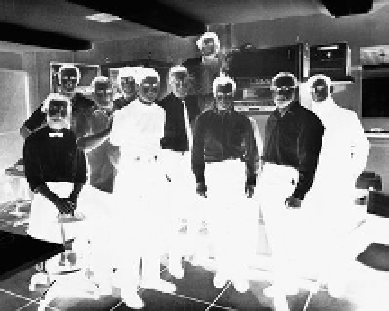Information Technology Reference
In-Depth Information
paid off and the expertise that the company developed in computing soon
became a major asset. BBN later bought the first PDP-1 from Digital Equipment
Corporation, the first relatively inexpensive computer that could be operated
by a single person. Licklider and his team used the machine to develop one of
the first time-sharing systems capable of supporting four simultaneous users. In
1966, BBN went to the Lincoln Lab to recruit an engineer named Frank Heart to
work on a hospital computer project. Heart was a graduate from MIT who had
taken MIT's first-ever course in computer programming. He had also earned
a master's degree while working on the Whirlwind project, the precursor to
the SAGE system, and then followed many other MIT graduates in moving to
Lincoln Lab to work on its portfolio of exciting real-time computing projects. By
the mid-1960s, when BBN recruited Heart, his Lincoln Lab colleagues were the
acknowledged experts in building real-time, interactive computing systems.
ARPA's request for quotation for building the IMP network arrived at BBN in
the summer of 1968. Bob Kahn, a professor of electrical engineering was at BBN
on leave from MIT (
B.10.12
). Kahn was an applied mathematician who had been
working on communications and information theory and wanted some real-
world engineering experience. With his work on the ARPANET, Kahn certainly
achieved his goal! Kahn had already sent some of his papers to Bob Taylor at
ARPA and the request for proposals landed first on his desk. The original hospi-
tal project for which Heart been recruited had not materialized, so he and Kahn
were tasked with putting together a team and a proposal to bid for the contract.
Heart was fortunate to recruit a strong team of experienced engineers, many of
whom had worked with him at Lincoln Lab - Will Crowther, to lead the soft-
ware team; Severo Ornstein, to lead the hardware effort; and Dave Walden, who
had four or five years' experience in programming real-time systems. Other key
members of the team were Bernie Cosell, whom BBN called “an ace de-bugger
whom every BBN manager had learned to rely on if their projects got into trou-
ble,”
20
and Ben Barker, an engineer from Harvard who played a vital role in get-
ting the actual hardware for the first IMPs debugged and working (
B.10.13
).
To simplify the design, Heart had insisted on “a clean boundary between
the host responsibilities and the network responsibilities.”
21
In their topic
Where Wizards Stay Up Late
, Katie Hafner and Mathew Lyon summarize the role
of the IMP as follows:
B.10.12. Bob Kahn studied at the
City College of New York and earned
his doctorate at Princeton University
in 1964. After working at Bell Labs
and then as a professor in electrical
engineering at MIT, he took leave
from MIT to work at BBN. With
Frank Heart, Kahn put together the
successful proposal for BBN to build
the ARPANET. Kahn is also co-author,
along with Vint Cerf, of the TCP/IP
protocols that underpin the present-
day Internet. The main idea of the
protocol is that networks should
be connected using gateways that
can translate the packets moving
between different networks.
B.10.13. A group photo of the IMP team at BBN in 1969. From left to right, Truett
Thatch, Bill Bartell (Honeywell), Dave Walden, Jim Geisman, Bob Kahn, Frank Heart,
Ben Barker, Marty Thrope (next to Heart), Willy Crowther, and Severo Ornstein.
Team member Bernie Cosell is not in the photograph.



Search WWH ::

Custom Search